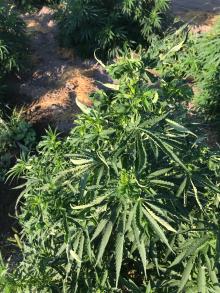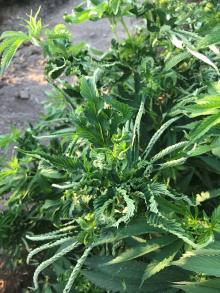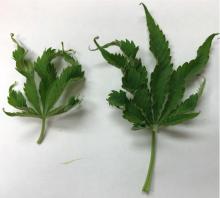By K. Frost and C. M. Ocamb
Cause Beet curly top virus (BCTV), which is spread by beet leafhopper (Circulifer tenellus). BCTV has an extensive host range infecting many common crops include bean, beet, sugar beet, cucurbits, spinach, potato, peppers, tomato, and certain annual flowers. Curly top is observed frequently on a range of crops in the Columbia Basin, southern Idaho, and central Oregon. Surveys of hemp done by OSU have shown that curly top can also be found in fields located in the Willamette Valley as well as in Southern Oregon, but incidence levels are much lower than those found in the Columbia Basin and central Oregon. Examinations of fields in central Washington by the OSU team also showed that BCTV infects hemp in that region, at higher incidence and severity levels compared to western Oregon. BCTV infects and overwinters in wild perennial or winter annual hosts, some of which are used by beet leafhopper for feeding and reproduction. Beet leafhopper acquires BCTV by feeding on infected plants and spreads the virus to annual crops in spring and summer. BCTV can be graft transmitted and is not thought to be spread on tools or in seeds. It is likely that this disease can be spread through vegetative propagation (i.e., taking cuttings from an infected mother plant). There are multiple strains of BCTV, but symptom variation due to BCTV strain has not been well characterized in hemp. Currently, there is no information on hemp varietal resistance to BCTV.
Symptoms Symptoms are variable and depend on plant variety and growth stage, temperature, and virus strain. The predominant symptom is stunting, leaf curling or twisting, and a pale-green-to yellow coloration of foliage. Leaves may exhibit puckering and upward curling or may remain green with a twisting of new growth and stunting of stem growth. In general, disease symptoms are more severe if plants are infected with BCTV in earlier growth stages. In some instances, plants can exhibit symptoms which they then appear to "out-grow" or individual plants may contain a mixture of symptomatic shoot portions along with "healthy."
Cultural control
- Monitor and manage beet leafhopper
- Roguing of BCTV-infected plants
- The use of reflective mulches may reduce virus spread.
Reference Giladi, Y., Hadad, L., Luria, N., Cranshaw, W., Lachman, O., and Dombrovsky, A. 2020. First report of Beet curly top virus infecting Cannabis sativa in western Colorado. Plant Disease 104(3):DOI.org/10.1094/PDIS-08-19-1656-PDN.




